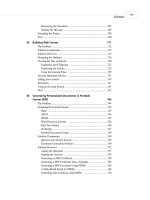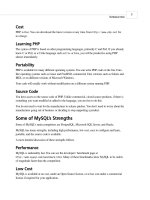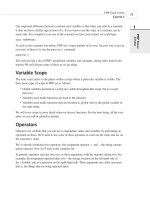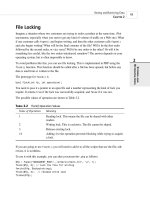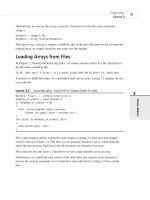Phát triển web với PHP và MySQL - p 8 potx
Bạn đang xem bản rút gọn của tài liệu. Xem và tải ngay bản đầy đủ của tài liệu tại đây (544.23 KB, 10 trang )
echo $num.”<BR>”;
$num++;
}
At the beginning of each iteration, the condition is tested. If the condition is false, the block
will not be executed and the loop will end. The next statement after the loop will then be exe-
cuted.
We can use a while loop to do something more useful, such as display the repetitive freight
table in Figure 1.7.
Listing 1.4 uses a while loop to generate the freight table.
LISTING 1.4 freight.php—Generating Bob’s Freight Table with PHP
<body>
<table border = 0 cellpadding = 3>
<tr>
<td bgcolor = “#CCCCCC” align = center>Distance</td>
<td bgcolor = “#CCCCCC” align = center>Cost</td>
</tr>
<?
$distance = 50;
while ($distance <= 250 )
{
echo “<tr>\n <td align = right>$distance</td>\n”;
echo “ <td align = right>”. $distance / 10 .”</td>\n</tr>\n”;
$distance += 50;
}
?>
</table>
</body>
</html>
for Loops
The way that we used the while loops previously is very common. We set a counter to begin
with. Before each iteration, we tested the counter in a condition. At the end of each iteration,
we modified the counter.
We can write this style of loop in a more compact form using a for loop.
PHP Crash Course
C
HAPTER 1
1
PHP CRASH
COURSE
45
03 7842 CH01 3/6/01 3:39 PM Page 45
The basic structure of a for loop is
for( expression1; condition; expression2)
expression3;
• expression1 is executed once at the start. Here you will usually set the initial value of a
counter.
• The condition expression is tested before each iteration. If the expression returns false,
iteration stops. Here you will usually test the counter against a limit.
• expression2 is executed at the end of each iteration. Here you will usually adjust the
value of the counter.
• expression3 is executed once per iteration. This expression is usually a block of code and
will contain the bulk of the loop code.
We can rewrite the
while loop example in Listing 1.4 as a for loop. The PHP code will
become
<?
for($distance = 50; $distance <= 250; $distance += 50)
{
echo “<tr>\n <td align = right>$distance</td>\n”;
echo “ <td align = right>”. $distance / 10 .”</td>\n</tr>\n”;
}
?>
Both the while version and the for version are functionally identical. The for loop is some-
what more compact, saving two lines.
Both these loop types are equivalent—neither is better or worse than the other. In a given situa-
tion, you can use whichever you find more intuitive.
As a side note, you can combine variable variables with a for loop to iterate through a series
of repetitive form fields. If, for example, you have form fields with names such as name1,
name2, name3, and so on, you can process them like this:
for ($i=1; $i <= $numnames; $i++)
{
$temp= “name$i”;
echo $$temp.”<br>”; // or whatever processing you want to do
}
By dynamically creating the names of the variables, we can access each of the fields in turn.
Using PHP
P
ART I
46
03 7842 CH01 3/6/01 3:39 PM Page 46
do while Loops
The final loop type we will mention behaves slightly differently. The general structure of a
do while statement is
do
expression;
while( condition );
A do while loop differs from a while loop because the condition is tested at the end. This
means that in a do while loop, the statement or block within the loop is always executed at
least once.
Even if we take this example in which the condition will be
false at the start and can never
become true, the loop will be executed once before checking the condition and ending.
$num = 100;
do
{
echo $num.”<BR>”;
}
while ($num < 1 );
Breaking Out of a Control Structure or Script
If you want to stop executing a piece of code, there are three approaches, depending on the
effect you are trying to achieve.
If you want to stop executing a loop, you can use the break statement as previously discussed
in the section on switch. If you use the break statement in a loop, execution of the script will
continue at the next line of the script after the loop.
If you want to jump to the next loop iteration, you can instead use the
continue statement.
If you want to finish executing the entire PHP script, you can use exit. This is typically useful
when performing error checking. For example, we could modify our earlier example as fol-
lows:
if( $totalqty == 0)
{
echo “You did not order anything on the previous page!<br>”;
exit;
}
The call to exit stops PHP from executing the remainder of the script.
PHP Crash Course
C
HAPTER 1
1
PHP CRASH
COURSE
47
03 7842 CH01 3/6/01 3:39 PM Page 47
Next: Saving the Customer’s Order
Now you know how to receive and manipulate the customer’s order. In the next chapter, we’ll
look at how to store the order so that it can be retrieved and fulfilled later.
Using PHP
P
ART I
48
03 7842 CH01 3/6/01 3:39 PM Page 48
CHAPTER
2
Storing and Retrieving Data
04 7842 CH02 3/6/01 3:37 PM Page 49
Using PHP
P
ART I
50
Now that we know how to access and manipulate data entered in an HTML form, we can look
at ways of storing that information for later use. In most cases, including the example we
looked at in the previous chapter, you’ll want to store this data and load it later. In our case, we
need to write customer orders to storage so that they can be filled later.
In this chapter we’ll look at how you can write the customer’s order from the previous example
to a file and read it back. We’ll also talk about why this isn’t always a good solution. When we
have large numbers of orders, we should use a database management system such as MySQL.
Key topics you will learn about in this chapter include
• Saving data for later
• Opening a file
• Creating and writing to a file
• Closing a file
• Reading from a file
• File locking
• Deleting files
• Other useful file functions
• Doing it a better way: database management systems
• Further reading
Saving Data for Later
There are basically two ways you can store data: in flat files or in a database.
A flat file can have many formats but, in general, when we refer to a flat file, we mean a sim-
ple text file. In this example, we’ll write customer orders to a text file, one order per line.
This is very simple to do, but also pretty limiting, as we’ll see later in this chapter. If you’re
dealing with information of any reasonable volume, you’ll probably want to use a database
instead. However, flat files have their uses and there are some situations when you’ll need to
know how to use them.
Writing to and reading from files in PHP is virtually identical to the way it’s done in C. If
you’ve done any C programming or UNIX shell scripting, this will all seem pretty familiar
to you.
Storing and Retrieving Bob’s Orders
In this chapter, we’ll use a slightly modified version of the order form we looked at in the last
chapter. We’ll begin with this form and the PHP code we wrote to process the order data.
04 7842 CH02 3/6/01 3:37 PM Page 50
We’ve modified the form to include a quick way to obtain the customer’s shipping address.
You can see this form in Figure 2.1.
Storing and Retrieving Data
C
HAPTER 2
2
STORING AND
RETRIEVING DATA
51
The HTML and PHP scripts used in this chapter can be found in the chapter2/ folder
of this book’s CD-ROM.
NOTE
FIGURE 2.1
This version of the order form gets the customer’s shipping address.
The form field for the shipping address is called address. This gives us a variable we can
access as
$address when we process the form in PHP, assuming that we are using the short
style for form variables. Remember that the alternative would be either
$HTTP_GET_VARS[“address”] or $HTTP_POST_VARS[“address”] if you choose to use the long
form (see Chapter 1, “PHP Crash Course,” for details).
We’ll write each order that comes in to the same file. Then we’ll construct a Web interface for
Bob’s staff to view the orders that have been received.
04 7842 CH02 3/6/01 3:37 PM Page 51
Overview of File Processing
There are three steps to writing data to a file:
1. Open the file. If the file doesn’t already exist, it will need to be created.
2. Write the data to the file.
3. Close the file.
Similarly, there are three steps to reading data from a file:
1. Open the file. If the file can’t be opened (for example, if it doesn’t exist), we need to rec-
ognize this and exit gracefully.
2. Read data from the file.
3. Close the file.
When you want to read data from a file, you have choices about how much of the file to read
at a time. We’ll look at each of those choices in detail.
For now, we’ll start at the beginning by opening a file.
Opening a File
To open a file in PHP, we use the fopen() function. When we open the file, we need to specify
how we intend to use it. This is known as the file mode.
File Modes
The operating system on the server needs to know what you want to do with a file that you are
opening. It needs to know if the file can be opened by another script while you have it open,
and to work out if you (the owner of the script) have permission to use it in that way.
Essentially, file modes give the operating system a mechanism to determine how to handle
access requests from other people or scripts and a method to check that you have access and
permission to this particular file.
There are three choices you need to make when opening a file:
1. You might want to open a file for reading only, for writing only, or for both reading and
writing.
2. If writing to a file, you might want to overwrite any existing contents of a file or to
append new data to the end of the file.
3. If you are trying to write to a file on a system that differentiates between binary and text
files, you might want to specify this.
The
fopen() function supports combinations of these three options.
Using PHP
P
ART I
52
04 7842 CH02 3/6/01 3:37 PM Page 52
Using fopen() to Open a File
Let’s assume that we want to write a customer order to Bob’s order file. You can open this file
for writing with the following:
$fp = fopen(“$DOCUMENT_ROOT/ /orders/orders.txt”, “w”);
When fopen is called, it expects two or three parameters. Usually you’ll use two, as shown in
this code line.
The first parameter should be the file you want to open. You can specify a path to this file as
we’ve done in the previous code—our
orders.txt file is in the orders directory. We’ve used
the PHP built-in variable $DOCUMENT_ROOT. This variable points at the base of the document
tree on your Web server. We’ve used the “ ” to mean “the parent directory of the
$DOCUMENT_ROOT directory. This directory is outside the document tree, for security reasons.
We do not want this file to be Web accessible except through the interface that we provide.
This path is called a relative path as it describes a position in the file system relative to the
$DOCUMENT_ROOT.
You could also specify an absolute path to the file. This is the path from the root directory
(/ on a UNIX system and typically C:\ on a Windows system). On our UNIX server, this
would be /home/book/orders. The problem with doing this is that, particularly if you are host-
ing your site on somebody else’s server, the absolute path might change. We learned this the
hard way after having to change absolute paths in a large number of scripts when the systems
administrators decided to change the directory structure without notice.
If no path is specified, the file will be created or looked for in the same directory as the script
itself. This will be different if you are running PHP through some kind of CGI wrapper and
will depend on your server configuration.
In a UNIX environment, the slashes in directories will be forward slashes (/). If you are using
a Windows platform, you can use forward or back slashes. If you use back slashes, they must
be escaped (marked as a special character) for fopen to understand them properly. To escape a
character, you simply add an additional backslash in front of it, as shown in the following:
$fp = fopen(“ \\ \\orders\\orders.txt”, “w”);
The second parameter of fopen() is the file mode, which should be a string. This specifies
what you want to do with the file. In this case, we are passing “w” to fopen()—this means
open the file for writing. A summary of file modes is shown in Table 2.1.
Storing and Retrieving Data
C
HAPTER 2
2
STORING AND
RETRIEVING DATA
53
04 7842 CH02 3/6/01 3:37 PM Page 53
TABLE 2.1 Summary of File Modes for fopen
Mode Meaning
r Read mode—Open the file for reading, beginning from the start of the file.
r+ Read mode—Open the file for reading and writing, beginning from the start
of the file.
w Write mode—Open the file for writing, beginning from the start of the file. If
the file already exists, delete the existing contents. If it does not exist, try and
create it.
w+ Write mode—Open the file for writing and reading, beginning from the start
of the file. If the file already exists, delete the existing contents. If it does not
exist, try and create it.
a Append mode—Open the file for appending (writing) only, starting from the
end of the existing contents, if any. If it does not exist, try and create it.
a+ Append mode—Open the file for appending (writing) and reading, starting
from the end of the existing contents, if any. If it does not exist, try and cre-
ate it.
b Binary mode—Used in conjunction with one of the other modes. You might
want to use this if your file system differentiates between binary and text
files. Windows systems differentiate; UNIX systems do not.
The file mode to use in our example depends on how the system will be used. We have used
“w”, which will only allow one order to be stored in the file. Each time a new order is taken, it
will overwrite the previous order. This is probably not very sensible, so we are better off speci-
fying append mode:
$fp = fopen(“ / /orders/orders.txt”, “a”);
The third parameter of fopen() is optional. You can use it if you want to search the
include_path (set in your PHP configuration—see Appendix A, “Installing PHP 4 and
MySQL”) for a file. If you want to do this, set this parameter to
1. If you tell PHP to search the
include_path, you do not need to provide a directory name or path:
$fp = fopen(“orders.txt”, “a”, 1);
If fopen() opens the file successfully, a pointer to the file is returned and should be stored in a
variable, in this case $fp. You will use this variable to access the file when you actually want to
read from or write to it.
Opening Files for FTP or HTTP
As well as opening local files for reading and writing, you can open files via FTP and HTTP
using fopen().
Using PHP
P
ART I
54
04 7842 CH02 3/6/01 3:37 PM Page 54


